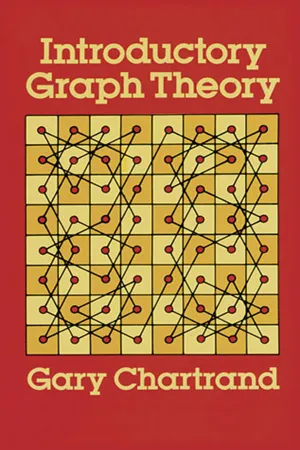
- 320 pages
- English
- ePUB (mobile friendly)
- Available on iOS & Android
Introductory Graph Theory
About this book
Graph theory is used today in the physical sciences, social sciences, computer science, and other areas. Introductory Graph Theory presents a nontechnical introduction to this exciting field in a clear, lively, and informative style.
Author Gary Chartrand covers the important elementary topics of graph theory and its applications. In addition, he presents a large variety of proofs designed to strengthen mathematical techniques and offers challenging opportunities to have fun with mathematics.
Ten major topics — profusely illustrated — include: Mathematical Models, Elementary Concepts of Graph Theory, Transportation Problems, Connection Problems, Party Problems, Digraphs and Mathematical Models, Games and Puzzles, Graphs and Social Psychology, Planar Graphs and Coloring Problems, and Graphs and Other Mathematics.
A useful Appendix covers Sets, Relations, Functions, and Proofs, and a section devoted to exercises — with answers, hints, and solutions — is especially valuable to anyone encountering graph theory for the first time.
Undergraduate mathematics students at every level, puzzlists, and mathematical hobbyists will find well-organized coverage of the fundamentals of graph theory in this highly readable and thoroughly enjoyable book.
Frequently asked questions
- Essential is ideal for learners and professionals who enjoy exploring a wide range of subjects. Access the Essential Library with 800,000+ trusted titles and best-sellers across business, personal growth, and the humanities. Includes unlimited reading time and Standard Read Aloud voice.
- Complete: Perfect for advanced learners and researchers needing full, unrestricted access. Unlock 1.4M+ books across hundreds of subjects, including academic and specialized titles. The Complete Plan also includes advanced features like Premium Read Aloud and Research Assistant.
Please note we cannot support devices running on iOS 13 and Android 7 or earlier. Learn more about using the app.
Information
Chapter 1
Mathematical Models

1.1 Nonmathematical Models
Problem Set 1.1
- 1. Give three examples of models you have encountered. Indicate some pertinent features of each model and describe a feature each model lacks which would be useful for it to possess.
- 2. Give an example of a model which is (a) larger than, (b) approximately the same size as the thing it represents.
- 3. Explain the relationship that radio, television, motion pictures, and the theater have with models. What are some of the pertinent differences in how these media model?
- 4. List some occupations which deal directly with nonmathematical models.
1.2 Mathematical Models
Table of contents
- DOVER SCIENCE BOOKS
- Title Page
- Copyright Page
- Dedication
- Preface
- Acknowledgments
- Table of Contents
- Chapter 1 - Mathematical Models
- Chapter 2 - Elementary Concepts of Graph Theory
- Chapter 3 - Transportation Problems
- Chapter 4 - Connection Problems
- Chapter 5 - Party Problems
- Chapter 6 - Games and Puzzles
- Chapter 7 - Digraphs and Mathematical Models
- Chapter 8 - Graphs and Social Psychology
- Chapter 9 - Planar Graphs and Coloring Problems
- *Chapter 10 - Graphs and Other Mathematics
- Appendix - Sets, Relations, Functions, and Proofs
- Answers, Hints, and Solutions to Selected Exercises
- Index